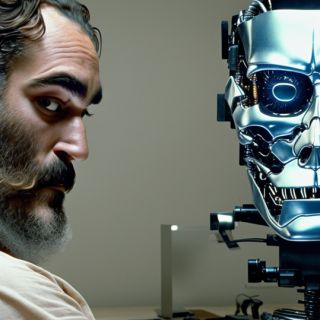Artificial Intelligence
The Merger of Artificial Intelligence and Psychiatry
It's all about pattern recognition.
Posted January 25, 2023 Reviewed by Vanessa Lancaster
Key points
- Human moods and behaviors are complex because they interplay our biology, psychology, and day-to-day interactions.
- AI is proving adept at understanding natural language, picking up on patterns and sentiment in text and large bodies of data.
- Applied to psychiatry, AI may provide tools to measure and detect patterns and associations currently too hard to discern.

Psychiatry is an art and a science, and artificial intelligence may provide tools to allow it to better understand what makes us tick.
True to this duality, I have always loved working with people as much as technology, especially the interplay between the two. I approach my work with engineering precision and record keeping, but I also pay close attention to both the "fuzzy" psychology of nurture, as well as the more medical biology of our "nature." Along these lines, I often tell patients that we aim to work on the "hardware and software" to understand ourselves better and optimize how we feel and perform.
Human behavior is complex, noisy, and sometimes even erratic. The arrival and popularization of usable, consumer-facing artificial intelligence in the form of GPT-3 marks a step towards understanding this complexity. With the ability to analyze and extract patterns from large amounts of data, AI may provide nuanced and specific insights into what makes each of us happy, healthy, and productive. It's not here yet, but quite soon, this will be a huge leap forward for providers, patients, and everyone who tracks mood, steps, heart rate, and sleep.
A Visual Art
Humans are highly visual creatures, and a disproportionate amount of our brains are dedicated to vision. Coincidentally, GPT-3 has shown us its astounding ability in artistry and linguistic analysis. A picture is worth a thousand words, and on the visual level, no one can argue that the art produced by DALL-E, an AI image generator, is magnificent. Sure, there's the occasional hallucination, extra finger, or creepy facial expression, but these faults are increasingly minor in comparison to the overall stunning "creativity" we see when we tell DALL-E to draw any scene in the style of Van Gogh.
We see visual patterns far more easily than text. This is why we like graphs and illustrations. As visual creatures, we might stop to appreciate the level of accomplishment and expertise in AI art. It's easier to recognize a great piece of art at a glance than an eloquent piece of writing. If AI can do what it can for language in art, it's pretty impressive.
AI art can be stylistically awe-inspiring, seeming creative, and falsely emotional. And the art looks great. Add more steps and processing, and it becomes almost perfect (gulp). Most people will sooner grasp the meaning or style of a work of art than a written poem or mathematical theorem. Our eyes are also much quicker to find faults and imperfections, and breaks in patterns. I know the art and chat of GPT-3 is an illusion of creativity and expertise, but it's still quite impressive in the visual domain. Its writing and textual analysis are not far behind.
A Fuzzy Science
Psychiatry, and more globally, human moods, represent an especially "fuzzy field." I have often compared it to weather forecasting–with seasons, daily variations, and a lot of variables influencing the outcome. We are still not good at predicting the weather more than seven days ahead. Much the same; no biometric device or app has been able to tell me I'm having a rough day.
It's hard to measure moods. Unlike other fields of medicine, there are few objective tests in psychiatry. There are a few labs to check and diagnostic tests (like ECGs) to order. Otherwise, it's questionnaires and interviews. Variations in sleep, diet, daily activity, socialization, and demands at home and work, can make it quite hard to predict moods or the outcome of a given intervention (like starting an exercise program, or a new supplement or medication).
For anyone who ever tracked their moods, it is clear that the data is so variable, so dependent on so many things, that it can be nearly impossible to tell what is working and what is not. This may be a reason so few of us stick to new interventions–ranging from taking supplements to regular exercise to getting another hour of sleep. The outcomes can be so variable and inconsistent, so thrown off by a bad day that it's really hard to see what is working and what is not. The signal is just too noisy. The patterns are too variable and dependent on too many things. This is why psychiatry is said to be as much an art as a science; it's subjective and complicated.
It's All About Pattern Recognition
Early in my career, one of my close mentors told me, "psychiatry is all about pattern recognition." He was right. More generally, all of medicine is about pattern recognition. All human interactions, from making coffee to finishing a project at work, involve the same. Furthermore, human wisdom may well be the culmination of experience and pattern recognition wrapped up in feelings.
Fascinatingly and frighteningly, we are at a crossroads in human history where computers are beginning to catch up to that "intelligence," which had always defined us as Homo Sapiens or "Wise Man." AI is becoming increasingly adept at pattern recognition–especially with language, and can now write screenplays, essays, poetry, and explain general relativity to a third grader.
Present-day AI (like ChatGPT) is akin to a sophisticated parrot—one who has been "fed" 45 terabytes of internet data, as of GPT-3. It can sound quite authoritative and well-versed, sometimes without really knowing what it is talking about. Numerous articles have been written on how changing the question or prompt results in quite varied answers. Experts have found it massively wrong on various detailed questions. Indeed, not all birds can fly. However, even without a deeper wisdom (which is the promise of artificial general intelligence), pattern recognition is a powerful tool that can tremendously benefit the fuzzy science of mental health.
Pearls From Big Data
We generate more information than we can understand. From biometric tracking devices, heart rate monitors, step counters, and sleep and mood trackers, we are flooded. Medical charts are full of detailed notes about symptoms, treatments, and the timing of interventions, often with years worth of data. Even in a well-planned randomized control trial, with a lot of factors controlled, the advantage of one intervention over another can often be quite subtle. In daily life, especially in mental health, the benefit of one intervention over another gets easily lost. Did those supplements you took for a month change anything?
For years I have wondered what patterns exist in my data that I am unaware of. The same is true for my patients: Is it better to exercise in the morning or the afternoon? Sleep seven hours or aim for eight? Did the ashwagandha supplements I took for a month improve anything? Did meditating daily for 10 minutes have any effect on my anxiety? My sleep? Or, in my work, does a given patient tend to do better with one antidepressant than another? Does increased sleep or socialization play a bigger role in overall mood?
Too much data. Lost associations. Currently, research-level statistics would be required to tease out these nuances. The data is there. It's just not practical to aggregate, analyze and extract cause and effects yet.
I have always been into biometrics, for myself as well as my patients, and I approach my charts as a coder. I take consistent notes on regular data points with each visit, mood, anxiety, sleep, impulse control, and cognition/learning ability (MASEIC for short). My hope has always been that one day, secure AI analytics could be applied to my large patient data set. The aim would be to find patterns and associations that I have missed. To tell me more about what works and what doesn't, or what works better.
Until GPT-4 starts listening, or we start measuring heart rate, skin conductivity, speech rate, and tone during visits, I'll stick to keeping good notes for later analysis. In the case of AI, more data is not a problem.
Will We Listen?
For the fuzzy field of psychiatry, pattern recognition will be a gold mine. Artificial Intelligence will serve as a powerful tool in a field where so much information is subjective, variable, and multifactorial. But will we listen to the results or suggestions?
Awareness may be key, as we all notice our speed as we drive past a "Your Speed Is—" sign. The hope is that with better objective feedback and clearer causality, we will be more motivated toward healthy behaviors. For practitioners, this may provide added support for choosing one intervention over another and provide objective feedback on progress and change.
It might take AI to show you that you are objectively and reliably happier if you spend time with friends, go to bed an hour earlier, exercise more, and stop eating after sunset. These interventions will be more actionable and "sticky" when an AI analysis actually confirms they are working and shows you the data to back it up.
Like a blood pressure reading or ECG, AI may finally provide some valuable metrics to the otherwise fuzzy art of psychiatry and mental health, which has always been missing objective metrics and tests.




